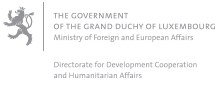- Home
- Preface
- Development Effectiveness
- World Humanitarian Summit
- I. Luxembourg’s official development assistance in 2016
- II. Cooperation with the main partner countries
- III. Regional cooperation and cooperation with other countries
- IV. Multilateral cooperation
- V. European Union
- VI. Cooperation with non-governmental development organisations
- VII. Humanitarian action
- VIII. Programme support
- IX. Development education and awareness raising
- X. Inclusive finance and the private sector
- XI. Evaluation
- XII. Report on the progress of the work of the Interministerial Committee for Development Cooperation in 2016
- Appendices
VII. Humanitarian action

Nepal earthquake 2015, © WFP/Mariko Hall
emergency.lu
In November 2015, in response to a request from the World Food Programme, a maritime antenna was deployed on a boat accommodating the UN teams in charge of the emergency operation in Yemen. This antenna provided connectivity for the humanitarian actors working on the boat in question until February 2016.
On 30 March 2016, the Ministry made an emergency.lu system available to UNICEF in order to combat a new outbreak of the Ebola epidemic in the eastern part of Guinea.
According to a March 2016 UNICEF report, nine new cases of Ebola had been recorded in Guinea in the Nzérékoré region. An emergency.lu antenna compensated for the lack of mobile telephony and local internet service providers, a situation which was damaging the capacities of the agencies (UNICEF, WHO, IOM, CDC) to react on the ground. Two volunteers from Luxembourg’s civil protection service installed the system, which was in operation for two months.
In October 2016, in response to the massive destruction caused by category 4 Hurricane Matthew, two volunteers from Luxembourg’s civil protection service and two emergency.lu satellite telecommunications systems were rushed to the site from the United Nations Humanitarian Response Depot (UNHRD) in Dubai. This was done at the UN’s request and provided internet connectivity to the humanitarian aid community and the government’s emergency units. Both systems were installed in the emergency agencies’ advance bases in Jérémie and Les Cayes. The emergency.lu terminals will be decommissioned at the end of January 2017 once the local providers’ services have been re-established.
In South Sudan, where emergency.lu has been present since January 2012, a system is still operational for UNICEF in Bor but the “emergency telecommunications cluster” (ETC) has just ended its operations at the end of 2016.
From 14 to 16 November 2016, emergency.lu supported “WFP in Action” in Rome, a joint simulation by various divisions of WFP (WFP IT Emergency Preparedness and Response Branch, SCOPE, VAM, Emergency Preparedness & Support Response, Communication, Field Security, Administration and Supply Chain). The simulation displayed the various solutions and services deployed on the ground to members of the WFP board of administration and head office staff in Rome.
As they do every year, the emergency services volunteers took part in a number of exercises and simulations at the European and international level, using and testing out the emergency.lu equipment.
emergency.lu also took part in the TRIPLEX exercise in Norway, the largest humanitarian exercise in the world, organised by the International Humanitarian Partnership (IHP) and co-financed by the European Commission.
The Ministry, in close collaboration with the Luxembourg Rescue Services Agency and the school of civil protection, organised and implemented the “Let’s Net” training course for ETC technicians. Twenty colleagues from various agencies and organisations took part in this training course in Schimpach.
As part of the emergency.lu project, various applications were also developed in 2016:
- The UNDAC Mission Software application, which enables improved coordination of the UNDAC teams deployed by OCHA through a file exchange. This application is connected to the “emergency.lu back-end.”
- The ETC Reporter application, which enables the WFP to track people and vehicles in the field and to visualise them on a map, to use mapping tools, to annotate the maps, to load photos and videos and to carry out all sorts of assessments via a solution which is easily adapted to the various needs and sectors.
- In 2014, the Ministry and UNHCR decided to digitise the UNHCR “Emergency Resource”. In 2016, the International Organization for Migration (IOM) requested the MFEA’s help in developing a similar system for the “emergency handbook” on the same platform developed for UNHCR in 2014.
In 2016, a total of 3,79 million euros was disbursed from the DCF under the emergency.lu project contract (2015-2020). In addition, 213 113 euros were disbursed to cover the costs of rolling out telecommunications systems, especially the costs of transporting the equipment and expenditure related to the missions and exercises.

